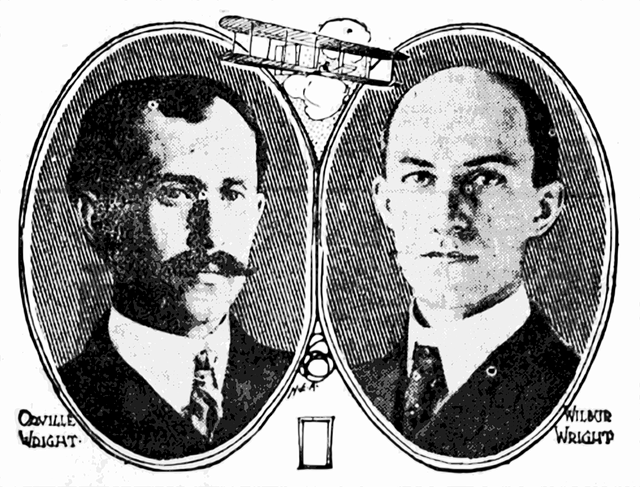“Model Teams” are articles written for team members and leaders looking for inspiration or just a good story about great success. Some are historical. Others are modern. All of them have been fun to put together. If you like them, please share.
Wright Brothers: Dedication, Sacrifice, Persistence, Hard Work
Few teams have influenced the world as much as the Wright Brothers. Their invention of modern, mechanized flight has changed the world in the way that we travel, ship supplies, patrol our borders, fight fires and wars. Their story is incredible. Below is just a summary, but please continue reading about them. There are various books, but my favorite is by David McCullough. You can find it here.
Model Team, The Wright Brothers – The Early Years, to provide some context
Wilbur Wright entered the world in 1867. Orville joined the family in 1871. Wilbur cared for his brother throughout their childhood. They played together and were nearly inseparable. Both were very studious. They excelled in their studies and found joy in continual learning at home. Both reflected fondly upon these times and even reminisced how they had an early fascination with flight.
To give a historical perspective, this was before Crayola had invented his first crayon box (1903) and before the first ice cream cone had even been publicly introduced (1904). Motion pictures were created in 1891 and played a part in documenting flight. 1891 is also the same year the zipper was invented though it wouldn’t be commonly used for another 20 years.
The boys had an eventful youth. One story from their youth was a hockey match played at one of the local ponds. The youth would gather and play hockey as often as the pond would hold them. As tends to happen in competitions, passions got a bit out of hand and Wilber got a stick to the face. (It was rumored that the assailant was famed Ohio serial killer Oliver Crook Haugh as a youth. Crazy, right?!).
Wilbur required many years for a full recovery. His physical recovery was rather quick, but his psychological recovery was much slower. He was depressed. He planned to go to Yale and pursue his education. Instead he was stuck at home recovering from a hockey game. He holed up at home and read numerous books to pass the time. One was on flight. The book changed his life. The science of flying was his new hobby.
Dayton, Ohio was a bustling place at this time. In fact, much of America was growing through the growing pains of the industrial revolution, a time with unprecedented city growth. Factories grew across the country, encouraging immigrants and rural citizens to move to the big city and steady employment. With growing cities came growing entertainment and economic gains. Dayton was once said to have been a foolproof place to start a business. The Wright Brothers decided the town need a newspaper, so they started one.
In 1889, West Side News was the first official venture the brothers participated in together. They covered mostly local events, though politics and entertainment news was also covered. In 1892, seeing an opportunity and a need to support the growing excitement for two wheel transportation, they opened Dayton’s first bike shop. The shop was successful enough to fund their other hobbies, one of which was flying.
The Goal of Flight
The state of flying at the time was nearly nonexistent. People created various forms of gliding apparatuses based on a host of theories and hypotheses. The brothers began their hobby by building standard gliding machines similar to that of a kite. It depended on steady wind and a lighter-than-air model to sustain gliding. Many well-funded scientists and engineers in many prominent scientific journals said it wasn’t possible to fly including Samuel Langley, a very well-funded flying enthusiasts who was the Secretary of the Smithsonian at the time. Their neighbors doubted. Their friends doubted. Just about everyone seemed to doubt, except the brothers. Based on what they saw, flying was possible.
Slowly, they began noticing that with some slight alterations, their gliding machines could be made better. Keep in mind, they were the first in the world to make these adjustments despite “professionals” telling them it couldn’t be done.
- The wings were adjusted to get greater lift, a must for a heavier-than-air aircraft.
- The brothers acted as pilots, a must to gain flying experience, literally risking their lives with every flight.
- Steering mechanisms were created that are still the foundation of mechanisms today.
- Finally, the propulsion was added, an engine that had to be specially made to fit the aircraft and the weight requirement.
These advancements in science didn’t suddenly happen. They were created precept upon precept. They learned something, then they applied it. Then they adjusted it. Afterwards, they would learn something else and apply it and adjust it. Sometimes one good idea would actually compound another and make the aircraft even better. Sometimes it would make it even worse requiring more experimentation. However, they continued to push forward.
The brothers put themselves on the path to success. They knew they needed a place with constant, steady wind, fairly easily accessible and in a small town to avoid drawing attention. They tried several locations, but decided on Kitty Hawk, North Carolina. Every year for four years the brothers would travel there and assemble their aircraft, ready for experimentation.
While in Kitty Hawk, they lived in a large tent, exposed to the outdoor mosquitos and rodents. They slept on cots and cooked on small, gas stoves, hardly the circumstances one would expect some of the world’s most influential scientists and engineers. During one of their visits the mosquitos relentlessly tormented the brothers so much that they nearly called the trip off. During the day they swatted until their skin reddened. At night, they pulled their sleeping bags all the way around their head so only their noses stuck out until the heat was unbearable. They then opened their sleeping bags to cool off, only to be met with a swarm of mosquitos which would cause them to close it again.
After four years and dozens of trips, the brothers had realized the world’s first heavier-than-air success. On December 17, 1903, they flew for just 120 feet. Thrilled by their success, they flew a second time for 175 feet, then 200, then 852 for a total of 1,347 feet or roughly .25 miles. Congratulating each other for their tremendous success, they headed home, but there would be no extended vacation. Improvements were still needed.
Continual Improvement
The story of the Wright brothers doesn’t end there. They continue to improve their flying machine. They decided to start building closer to home and for the next three months, they failed more than they succeeded, but eventually everything started to click. After several successful runs of straight flying, they decided flight wouldn’t be commercially viable unless the plane could turn. They set more goals and continued pushing forward until 1906 when the brothers flew more than 20 miles in circles and only landed their plane because of a shortage of fuel.
Their original plane and some of the subsequent models can be found in the Smithsonian Air and Space Museums.
These two brothers formed an extraordinary model team that faced the doubts, sacrificed and pushed forth in their pursuit of what they believed to be a better world, a world where man could fly.


